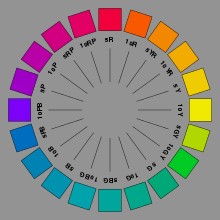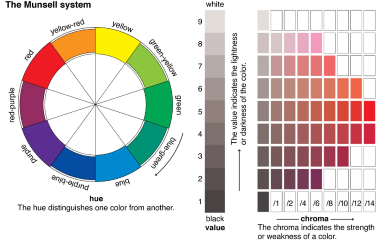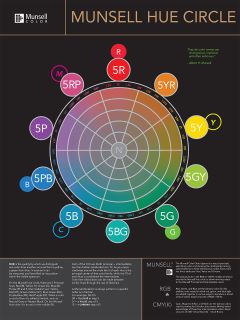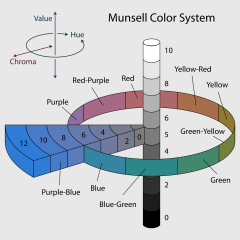| A Guide to the Munsell Colour System |
 |
| The Munsell color system is a color notation system created by the American artist and professor Albert H. Munsell in the early 20th century. It is based on the three dimensions of color perception: hue, value, and chroma.
In the Munsell system, hue refers to the basic color family, such as red, yellow, green, blue, or purple. Value refers to the lightness or darkness of a color, while chroma refers to the saturation or intensity of a color.
The Munsell system uses a three-dimensional color space to represent colors, with hue, value, and chroma arranged in a cylindrical coordinate system. The hue is represented by an angle around the circle, with red at the top, yellow at the right, green at the bottom, and blue at the left. Value is represented by vertical positioning, with white at the top and black at the bottom. Chroma is represented by radial distance from the center of the circle, with more saturated colors towards the edge of the circle.
The Munsell color system has been widely used in many fields, such as art, design, and science, and is considered one of the most accurate and consistent color systems.
|
| History of the Munsell Colour System |
 |
|
The Munsell color system is a widely used system for describing and specifying colors. It was developed by American artist and professor of art, Albert H. Munsell in the early 20th century. Munsell was born in Boston in 1858 and studied art at the Massachusetts Normal Art School. He became interested in the scientific study of color and began to develop his own color notation system in the late 19th century.
Munsell's system is based on the three dimensions of color: hue, value, and chroma. Hue refers to the basic color families, such as red, yellow, and blue. Value refers to the lightness or darkness of a color, and chroma refers to the purity or intensity of a color. The Munsell system is often represented in a three-dimensional space known as the Munsell color solid, which shows the relationship between hue, value, and chroma.
Munsell published his system in a book called "A Color Notation" in 1905, and it quickly gained recognition in the scientific and artistic communities. It was particularly useful in fields such as printing, where accurate color reproduction was important. The system was also used in the design of camouflage during World War I.
In the following years, Munsell continued to refine and develop his system, and it became widely adopted as a standard for color notation. In 1921, the Munsell Color Company was established to manufacture and sell color charts and other color measurement tools based on the Munsell system. The company still exists today as part of X-Rite, a leading manufacturer of color management solutions.
The Munsell system has been influential in many fields, including art, design, printing, and color science. It remains one of the most widely used systems for color specification and has inspired many other color systems and models.
|

Albert H. Munsell

Munsell Colour Wheel
|
| How to Use the Munsell Colour System |
 |
- Determine the hue of the color you want to describe. The Munsell system divides hues into five principal categories: red, yellow, green, blue, and purple. Within each category, there are numerous sub-hues that are designated by a letter or number.
- Determine the value of the color. This refers to the lightness or darkness of the color, and is measured on a scale from 0 (black) to 10 (white).
- Determine the chroma of the color. Chroma refers to the intensity or saturation of the color and is measured on a scale from 0 (neutral gray) to a maximum value that depends on the hue and value.
- Combine the hue, value, and chroma measurements to describe the color using Munsell notation. The notation is expressed as three values separated by slashes, with the hue represented by a letter or number, the value by a number from 0 to 10, and the chroma by a number from 0 to a maximum value that depends on the hue and value. For example, the Munsell notation for a moderately light, highly saturated yellow-green color might be 5GY 8/14.
Note that the Munsell color system is often used in combination with other color systems, such as the RGB or CMYK systems, to ensure accurate color reproduction across different media.
|

Munsell Colour System
|
| Why Use the Munsell Colour System |
 |
- Standardization: The Munsell system is based on a fixed set of color samples that have been carefully selected and calibrated to provide consistent and reliable color measurements. This standardization allows for accurate communication of color information across different industries and applications.
- Three-dimensional color space: The Munsell system uses a three-dimensional color space that allows for a more intuitive and comprehensive understanding of color relationships. The dimensions of hue, value, and chroma provide a systematic way to describe the characteristics of a given color.
- Flexibility: The Munsell system can be used to describe a wide range of colors, from subtle variations in hue to bold variations in chroma and value. This flexibility makes it useful in a variety of industries, from art and design to manufacturing and scientific research.
- Accessibility: The Munsell system is easy to use and understand, even for people without specialized training in color theory or measurement. This accessibility makes it a popular choice for anyone who needs to communicate or analyze color information.
|

Munsell Hue Circle
|
| Who Uses the Munsell Colour System? |
 |
|
The Munsell color system is used by a wide range of professionals, including artists, designers, scientists, and engineers.
Artists use the Munsell color system to create harmonious color combinations and to accurately communicate color information to clients and other artists.
Designers use the system to choose colors for products, branding, and marketing materials.
Scientists and researchers use the Munsell color system to classify and communicate color information in fields such as geology, biology, and forestry.
Engineers and manufacturers use the system to ensure consistent and accurate color reproduction in products such as textiles, plastics, and paint.
The Munsell color system is also used in education, particularly in courses related to color theory and visual design.
|

Colour Wheel
|
| Munsell Colour System VS. other systems |
 |
- Three-dimensional representation: Unlike other color systems that represent colors as a two-dimensional circle or a linear spectrum, the Munsell color system represents colors in three dimensions. This allows for a more accurate and nuanced representation of color.
- Hue, value, and chroma: The Munsell color system uses three dimensions to represent color: hue, value, and chroma. Hue refers to the color itself, value refers to the brightness or darkness of the color, and chroma refers to the purity or intensity of the color.
- Standardized notation: The Munsell color system uses a standardized notation to describe colors, which makes it easier to communicate and reproduce colors accurately. The notation consists of three parts: the hue, value, and chroma, represented by a letter and number combination (e.g., 5YR 5/10).
- Based on perceptual experience: The Munsell color system was developed based on perceptual experience, rather than mathematical formulas or physical measurements. This means that it takes into account how humans perceive and experience color, which makes it more useful in practical applications.
Overall, the Munsell color system offers a more comprehensive and intuitive approach to understanding and describing color, which has made it a popular choice among artists, designers, and scientists.
|

Graph
|
| Additional Resources |
 |
|
If you have questions about any of our services or products, don't hesitate to contact us. Our knowledgeable staff is always happy to assist with answers, advice, or suggestions.
|
|

|



|
USA Giclee On Canvas, Fine Art Printing - Art Scanning & Reproductions - Handmade Oil Paintings - Custom Wood Panels, Metal Picture Framing - Block/Plaque Mountings, Large Format Dry Mounting & Lamination - Art Supplies: Stretcher Bars, Cradled Wood Panels and Artist Canvas - Collages On Canvas - Plexi/Acrylic Face Mounts - Block Acrylics, Fabric Printing, Dye Sublimation - Cityscape Skyline Prints, Resin, Photo Gifts and more...
|
|
© 2002-2025 - KeenART Media Ltd.
|
|
| |
|
